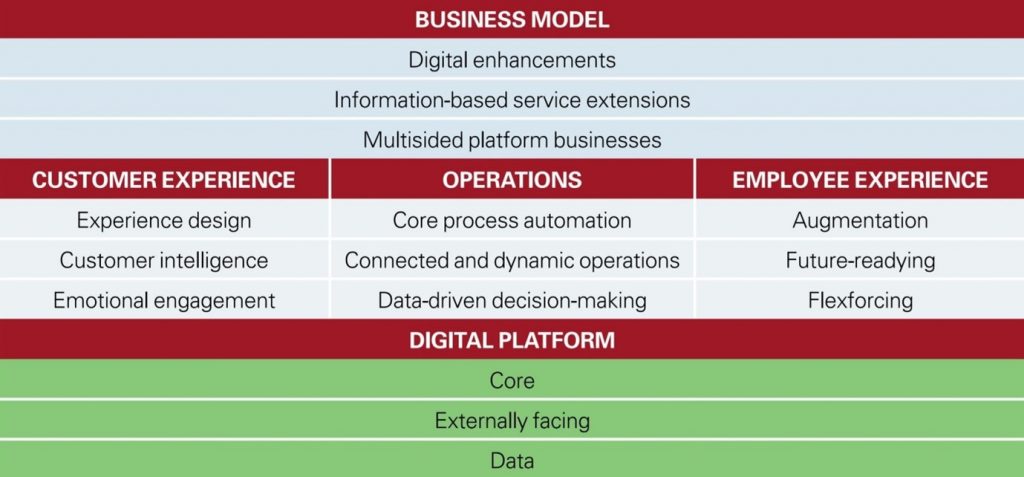Digital transformation is a hot topic for companies across the globe. Companies are moving forward with digital transformation at varying paces and experiencing varying levels of success. Some are transforming many parts of their organisations while others are still doing only the basics. Others are encountering organisational issues or other challenges that prevent them from transforming successfully. But one thing others found out is that the best companies combine digital activity with strong leadership to turn technology into transformation. Covid 2019 has brought new urgency to leverage digital transformation at almost every level.
This note is a summary and my personal experience of change management approach.
What is digital transformation?
Digital transformation is the integration of digital technology into all areas of a business, fundamentally changing how you operate and deliver value to customers.

Changes from their initial 2014 publication here, the framework is updated with customer experience, business model innovation, and structured on the digital platform. The research can be read here. Not all companies in their survey adopt all those elements. Instead, they pick some which are relevant and suitable for their company.
Transforming customer experience
The research in 2014 pointed out the linear approach one company needs to do if they trigger changes. It starts with customer experience transformation – the initial drive for any change. If in the research of 2014, authors emphasized customer understanding and effort to enhance any touch points with them, the 2020 updated version mentioned emotional engagement which is more specific. In one study, emotionally engaged customers were shown to be 52% more valuable than highly satisfied customers (source: MIT Sloan). I agree with this point. End customers now are caught or exposed to a huge of media coverage. Their taste and online behaviors change continuously and in a complex way. Engagement is the first battle before winning one customer’s loyalty. Engagement, in addition, is another fundamental metric for marketers to see how effective and efficient their campaign is.
Transforming operation
The operation block also witnesses a slight change after years. The 2020 updated version prioritises core process automation that builds up competitive edges for a business. Platforms can not create a seamless experience internally and externally without a smooth connection and dynamic approaches. In recent years, the basis for operational decisions has increasingly shifted from backward-looking reports to real-time data. Now, connected devices, new machine learning algorithms, smarter experimentation, and plentiful data enable more-informed decisions. This capacity is spreading to strategic and marketing decisions, too. Digital masters are taking advantage of this by integrating operational and strategic decision-making in new and powerful ways.
Transforming employee experience
As the main source of digitalised operation changes, companies have begun to focus on the employee experience as intently as they do on the customer experience. It was separated and developed as another building block. Three elements of employee experience transformation have emerged in recent years: augmentation, future-readying, and flexforcing.
In my experience of digital transformation at SMEs, without gradual motivation and coaching, staff find it confusing, complicated, and resistant to change. Especially when companies tend to adopt more robotics and digital technologies to augment employee productivity and performance — enabling people to work faster, smarter, and more safely.
Like customers, staff now are exposed to more opportunities and are open to change, or relocate more. The HR team can address flexforcing easier though there are facts that it also challenges HR team and cause considerably more cost of recruitment. In the UK, for instance, following Brexit, corporates tend to pay more costly to hire skilled European and other overseas labor or they will face a time-consuming recruitment process to hire domestic ones.
Transforming business model
Think of business model transformation, we normally think of a systematic change that takes lots of effort and investment. In 2014, authors found that only 7% of companies were using digital initiatives to launch new businesses and only 15% were creating new business models with digital technology.
Times have changed, especially during pandemic, the demand for digital transformation at all level are high demanding. It fuels company to work under unexpected situation that how digital prowess can yield business model innovation. Business model transformation doesn’t always require disrupting a company or industry. Increasingly, companies are finding ways to digitally enhance their existing business models without requiring major changes to the business.
Launching a successful multisided platform ecosystem requires specific economic conditions, heavy investment, and a strong dose of luck to reach a profitable scale. So not every company should try to become the platform leader for its industry. But companies that cannot create their multisided platforms can still use platform economics to partially transform their business models or find an economically viable role to play in platforms operated by others.
Digital platform
I support this updated framework with digital platform elements which contributes to the prompt scaling up of a business change. The digital platforms break down what a corporate would like to showcase to customers and their staff, step by step. It plays an essential role in any block-building transition from customer experience, to operation performance management. It works as a coaching platform for staff. The advances in advertising platforms including marketing technologies like Salesforce, Microsoft Dynamics 365, and Hubspot are typical examples as it completely changes the way one company automates marketing operation, and scales up email marketing and the methods of receiving messages and type of message to audiences.
Norwich,
Kate N.
Original report source: MIT Sloan